



























Fancy Schmancy Russian Garb
from class taught at Gulf Wars XVI by
Lady Sofya la Rus and Master Mordak Timofe'ivich Rostovskogo
Introduction:
-
Kievan Rus – 9th-13th century (until Mongols)
Mongol (Appanage) Rus – up to 15th century
Muscovite Rus - from 15th cent. until reforms of Peter the Great
General cultural continuity, increasing Eastern influence
-
Rus had close ties to Byzantium
Viking warrior-merchants were prominent in early period
Finnic tribes shared the lands in the north
Trade with Western Europe was strong.
Trade with Central Asia/Middle East even stronger. (They had nicer stuff, after all. )
-
Linens and wools were primary fabrics.
Fine imported wools and silks were for the outermost garments in holiday costumes.
Furs extensively used.
-
Peasants – wolf, fox, bear, rabbit, squirrel, sheepskin
Wealthy – beaver, otter, sable, marten
Russians had essentially the same dye stuffs as Western Europe and so had access to the same wide range of colors - reds, black, blues and greens were especially favored.
-
Block printing–geometrical, stylized animals, plants
Imported brocades and silks with Eastern-style
Contrasting fabric edging and fur trim
Galloon braid (tablet weaving?) edging
Embroidery with silks, pearls, sequins, cabochen gems, metal plaques.
Embellished applique/borders
Accessories – cuffs, collars, jewelry, etc.
-
Foliage: intricate/whimsical curved stems, stylized flowers, Tree of life
Geometric: circles, crescent moon-images ("lunnitsy"), motifs of nets (pletenki), interwoven strands
Religious: saints, crosses, pagan symbols
Animals and birds: horses, ducks, lynx, dogs, griffons, etc.
Humans: dancers, musicians, entertainers
Architectural: arches, pillars
-
Imported brocades and silks with Eastern-style
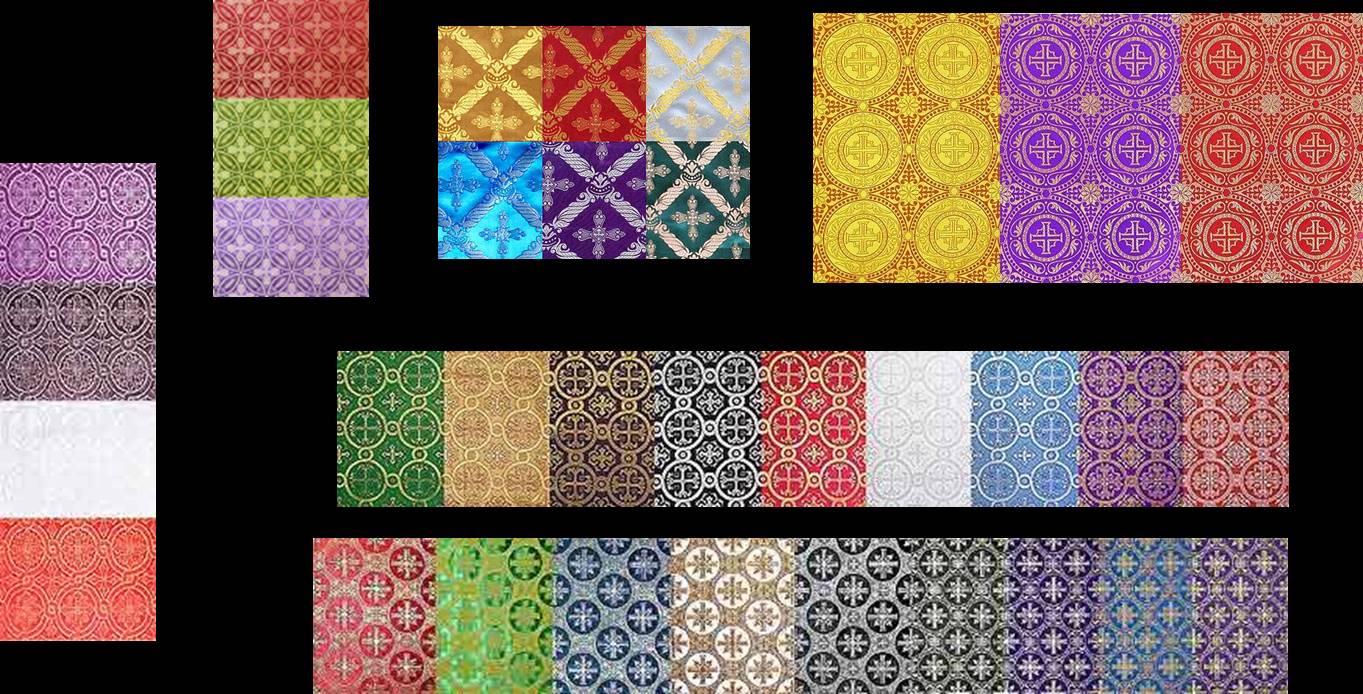
-
Embroidery decorated the clothing of all levels of ancient Russian society.
Peasant clothes, particularly the shirt, were embroidered with simple geometric and plant forms, usually in red, but sometimes in unbleached white.
The garments, themselves, not as heavily embroidered in Kievan period as they would be in the Muscovite period when clothes could be almost completely encrusted.
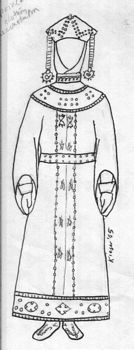 Emphasis on ornate accessories – separate/interchangeable collars, cuffs, voshvy (see below)
Emphasis on ornate accessories – separate/interchangeable collars, cuffs, voshvy (see below)
Voshvy were embellished panels of cloth used as garment borders, etc. made to be basted onto other garments (to get as much use as possible out of these valuable works of art).
-
Running stitch
Double running stitch (Holbein stitch)
Split stitch
Chain stitch
Satin stitch
Couching
Note absence of cross-stitch. I have not yet learned when that appeared in Russian embroidery - I have certainly seen no evidence of it prior to the 14th cent. so far.
-
Red, blue, brown, yellow, green, white and natural silk and linen used with gold and silver.
Embroidery with metal thread on costume not only of nobility, but also affluent city dwellers and villagers.
Domestic workshops made fine spun-gold (or gilded silver) thread with linen.
-
11-12th cent. used a special running stitch - long stitches on front side and short ones on the back - like machine sewing with bobbin thread too tight.
12-13th cent. thread was arranged on fabric and couched with silk.
Closely resembles opus anglicanum.
-
Pearls were widely utilized in boyar clothing, and surprisingly common even in peasant clothing.
By the 10th century, pearl embellishment was lavish.
Clothes saturated with pearls were known and independent patterns of pearls began to appear.
Seed pearls were sewn onto fabric widely spaced, or outlining a pattern sewn with thread, or "in dots" formed by the pearls themselves.
Small freshwater pearls came from native rivers or imported from Iran.
Cultivated pearls were used in the 10th-13th centuries.
Most Russian period embroideries used potato-shaped pearls drilled horizontally (opposite the way pearls are usually drilled today). Apparently "rice krispie" pearls were also used.
Liudmila's Pearling Technique:
-
Couch down a foundation of white cord (single or double line)
Stitch down the pearls over this foundation, making stitches after every single pearl (I like to string the pearls first, then couch down the string down.)
Outline your design in gold cord, which hides the white.
If the stitches holding down the pearls and the gold, go just through the white cord foundation, and NOT through the underlying fabric…
Then when the garment gets ruined, the embroidery can be taken off in one piece and readily attached to a new garment.
Gems:
-
Ruby, emerald, sapphire, turquoise, and tourmaline.
Agate, some amethyst, rough diamonds, evidence of *some* jade from the Orient trade, jet, emerald / beryl /chrysoberyl, garnet.
Mostly cabochen-cut, some squarish…irregular.
Thin bands of metal around each one attached to clothing by metal pronged findings.
Metal Plaques:
-
Decoration with "alamami" - silver and gold engraved/embossed badges/plates - gave clothing special splendor and festiveness.
Mentions of "pearl alamax" are found in various documents.
Such ornaments were very expensive and, of course, passed down in inheritance.
Male Headdress:
-
Hats “required”
Large variety, tall or short, felt or broadcloth, with or without fur lining
Commoners tended to favor tall, conical hats.
Nobility favored more rounded forms.
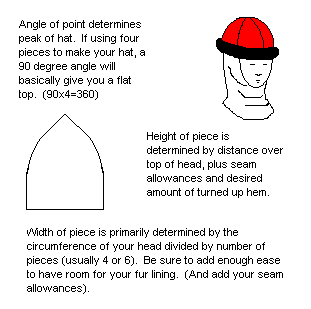

Maiden's Hair and Headdress:
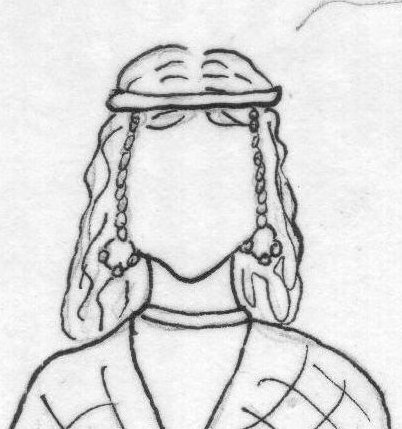
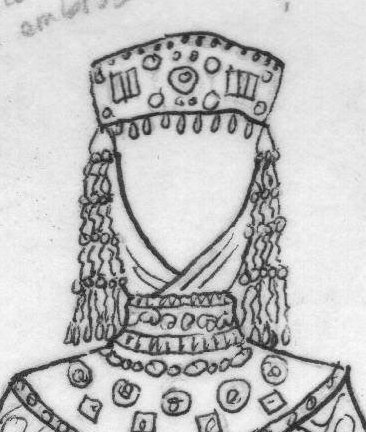
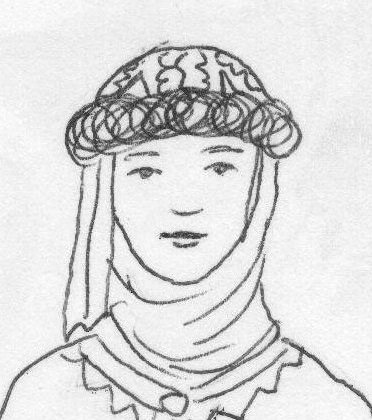
-
Per Kolchin - illustrations copyrighted, so not reproduced here.
-
Pearlwork
Engraving
Embossing/stamping
Niello/blackwork
Casting
Granulation
Filigree
Enamel
Highly developed - predecessors to the Faberge eggs.
Most jewelry made of metal
-
Peasants used copper, bronze, low-grade silver
Nobility used silver and sometimes gold
Colored glass was popular for rings and bracelets.
-
Earrings not as common as temple rings for women in Kievan Period.
Men wore more earrings, but only in one ear (left ear?).
Temple rings had regional forms; attached to hair, headdress (or ears).
Kolti – hollow metal disks, often filled with cloth soaked in aromatic oils, worn much like temple rings
Temple rings seem to have gone out of fashion with the Mongol conquest, and the kolti soon after.
Illustration: Temple rings are shown on the left, and kolti are on the right.
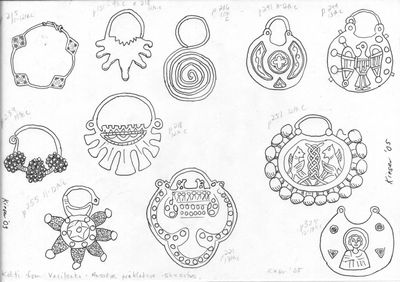
-
Chains/strings hanging from headdress at the temple
Kolodochek – little logs of metal strung together, or
Simple chains, or
Precious metal medalions similar to the kolti
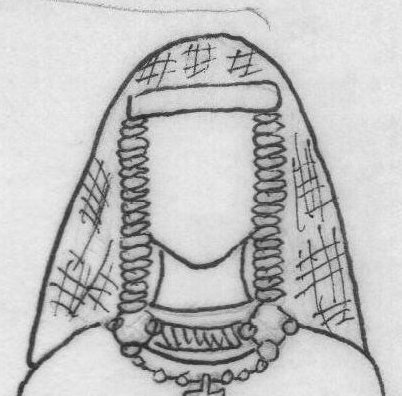

-
In early period, men wore heavy hoops of jute or braided wire (grivna).
Very similar to Viking items.
Small crucifixes on cords or chains were worn
Women favored glass beads of immense variety, but also pearls, metal beads, and the heavy hoops like the men.
Metal chains could be very valuable.
Medallions from simple cast tin alloys up to filigreed gold with jewels were popular.
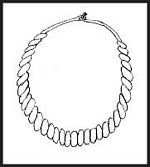
-
Decorated detachable collars were popular
Could be narrow stand-up collars or wide, shoulder-covering round collars
Made of finest fabric and ornaments mounted on a stiff base (leather, birchbark - Mordak and I use felt)
Matched similar removable cuffs
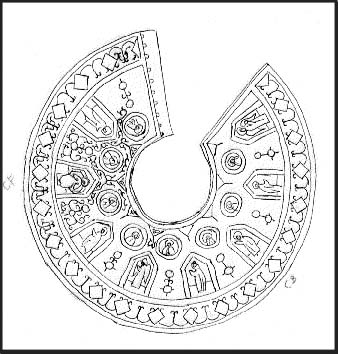
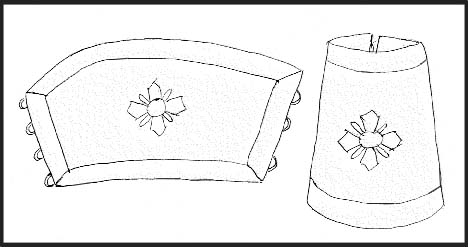
-
Rings set with stones were especially popular for women, but men wore as well.
Ring forms often matched those of bracelets.
Bracelets could be made of linked disks.
Rings and bracelets made of metal or colored glass.
Seal/signet rings also existed.
Illustration Below: glass bracelets are shown with their cross-sections on the lower right.
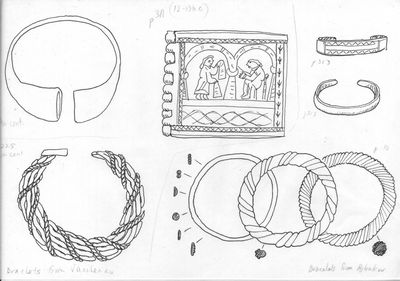
Illustration Below: glass rings shown on left, metal on the right.
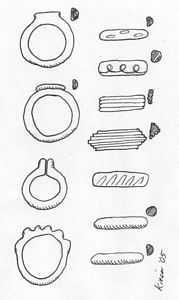
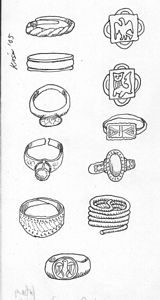
-
Many served as amulets, others seem practical (like chatelaines)
Worn on long cord or chains fastened to belt or chest of dress
Little bells were popular with all classes.
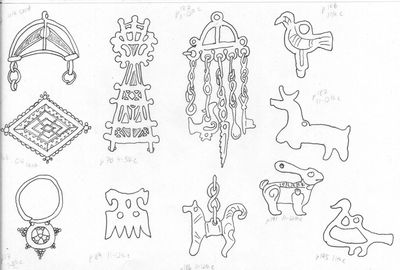
-
Belts for the rubakha were fabric or leather less than 1 inch wide,
White, blue, red, embroidered or trimmed with contrasting color.
Could have metal buckles. (Mostly for men)
Card woven? Other decorative techniques?
Belts for outer layers of clothing could be as extravagant as gold-embroidered silk or even linked gilded plates.
-
Purses worn on belts or over the shoulder since there were no pockets.
See Prof Michael Fuller's website for photos
-
Bast shoes, lapti, for peasants woven of inner bark of trees.
Simple untanned leather slippers also for peasants
Fancier tanned leather shoes for wealthy peasants, city-dwellers and nobility.
See Prof Michael Fuller's website for photos
-
Ankle or knee-high boots preferred by the more prosperous.
Common boots were rounded in the toe, with a straight top.
Ruling class could have slightly turned up toes and tops cut higher in front than back.
No heels until 14th century.
Colored hides, tooling, and embroidery applied according to wealth
See Prof Michael Fuller's website for photos
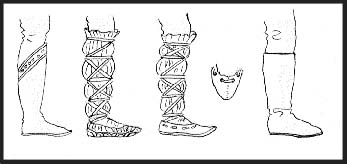
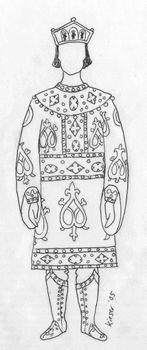

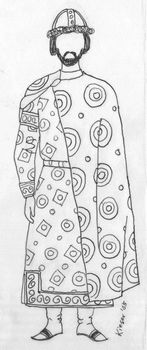
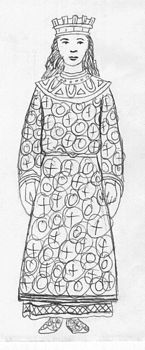
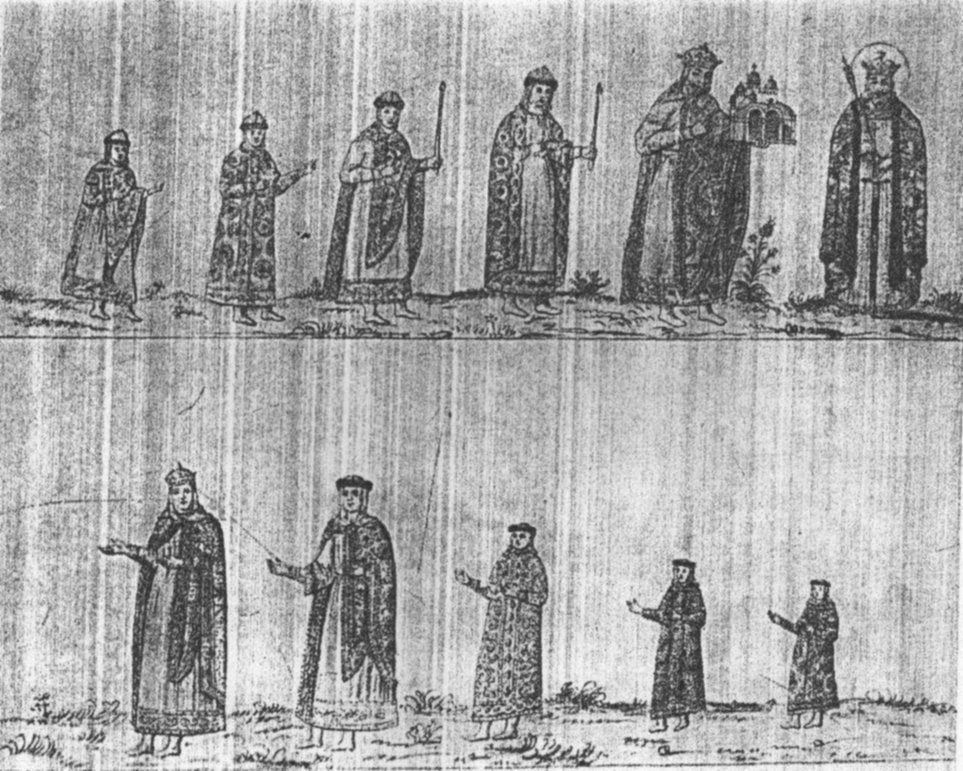
-
Kireyeva, E.V. The History of Costume. Enlightenment, Moscow, 1970.
Kolchin, B.A. and T.I. Makarova. Drevnaia Rus, Byt I Kultura. Science, Moscow, 1997.
Pushkareva, Natalia. Zhenshchiny drevney Rusi. 1989.
Rabinovich, B.A.. Drevyaya Odezhda Narodov Vostochnoj Evropy. Science (Nauka), Moscow, 1986.
Rybakov, M.G. Russian Applied Art of the 10th-13th Centuries. Aurora, Leningrad, 1971. Stamerov, K.K. An Illustrated History of Costume. Avenger, Kiev, 1978.
Tolmachoff, Eugenia. Ancient Russian Ecclesiastical Embroideries. Available at the On-Line Digital Archive of Documents on Weaving and Related Topics: //www.cs.arizona.edu/patterns/weaving/articles/nb47_emb.pdf
-
//knowledgepages.scadianrus.org/dress.html – SIG
//members.aol.com/Predslava/Giliarovskaia/Patterns.html
//www.ozemail.com.au/chris&peter/trmain/tr1main.html - temple rings
//members.aol.com/LiudmilaV/Headwear.htm - headdresses
//tulgey.browser.net/~kate/sca/rus – medieval Russian embroidery
//users.stlcc.edu/mfuller/novgorodpublic.html – Michael Fuller’s photos
//www.strangelove.net/~kieser/Russia - my Russian stuff
COPYRIGHT (c) 2007 by Lisa Kies and Tim Nalley. You may make copies for personal use and to distribute for educational purpose but only if it remains complete and entire with original authorship clearly noted.
Back to Russian Material





























